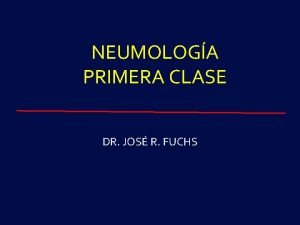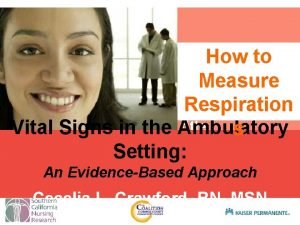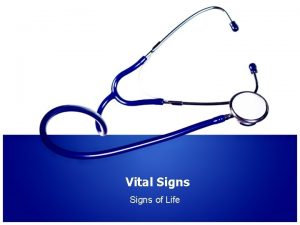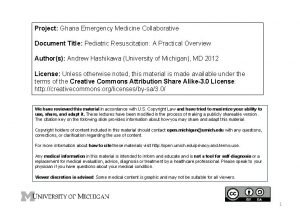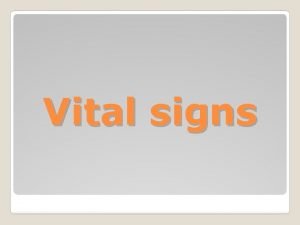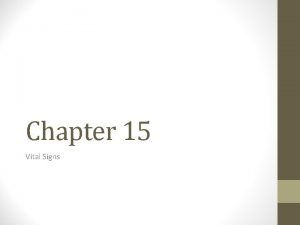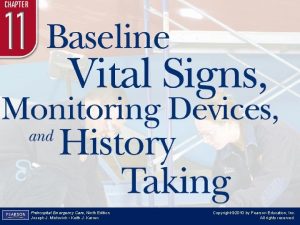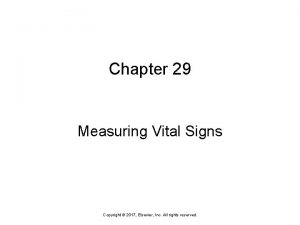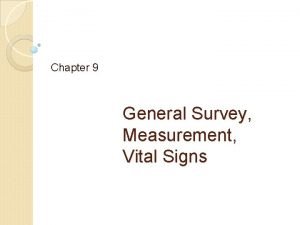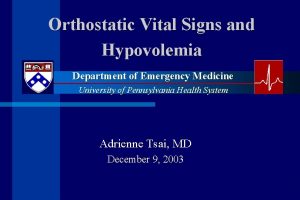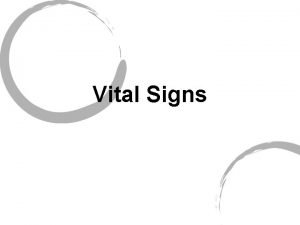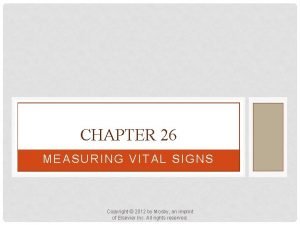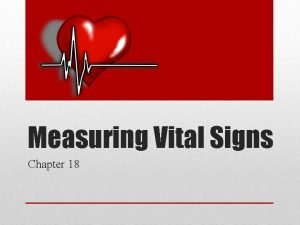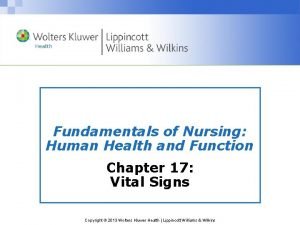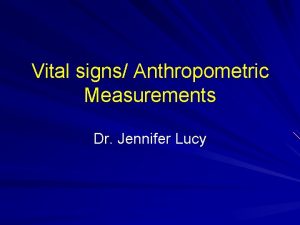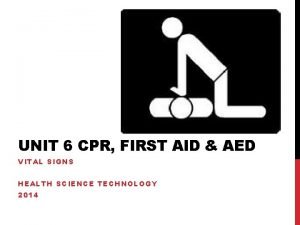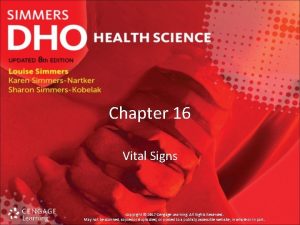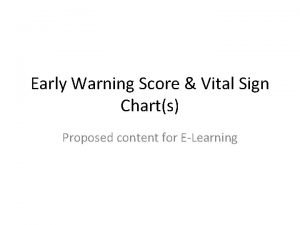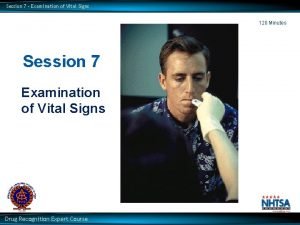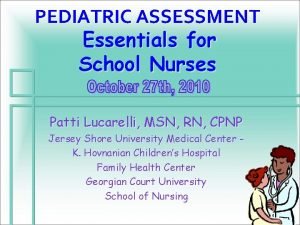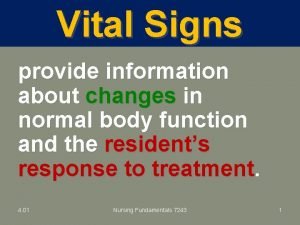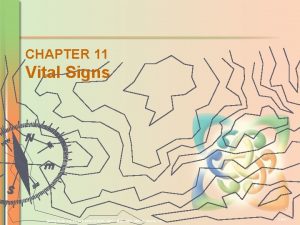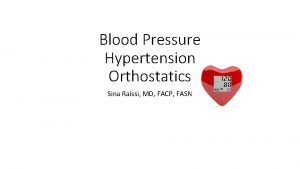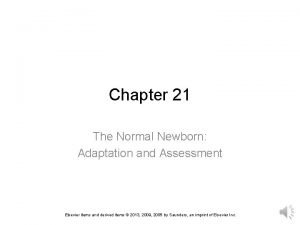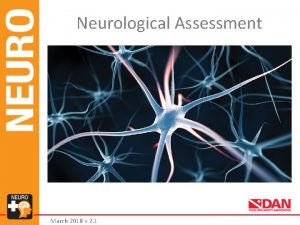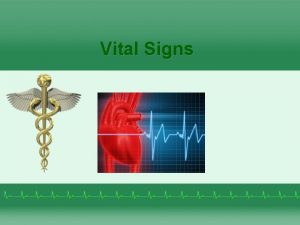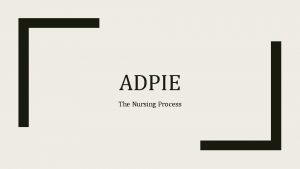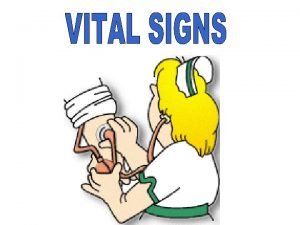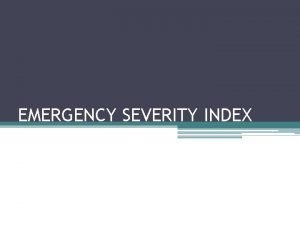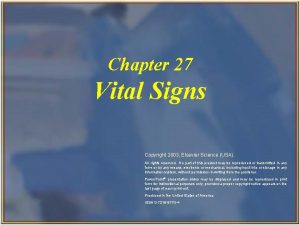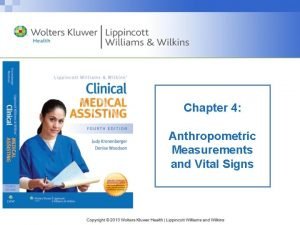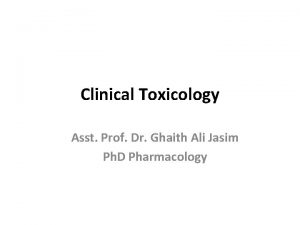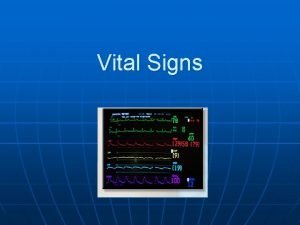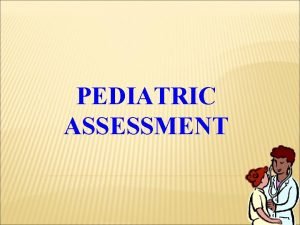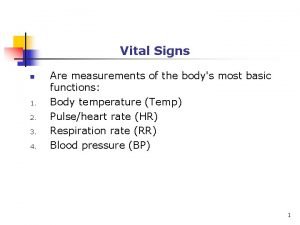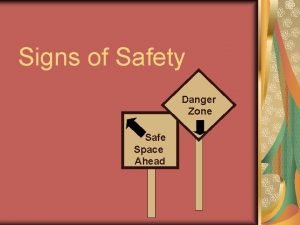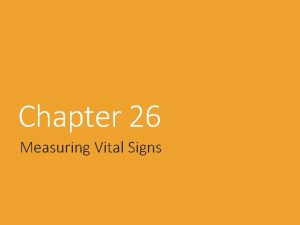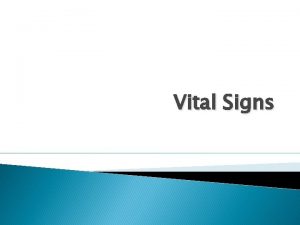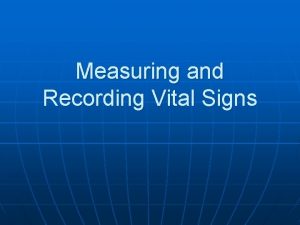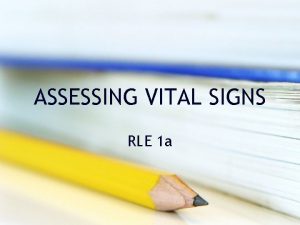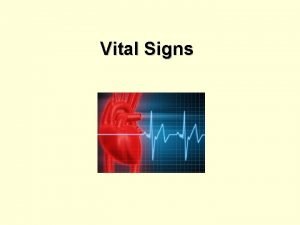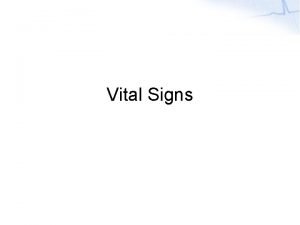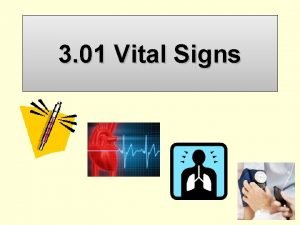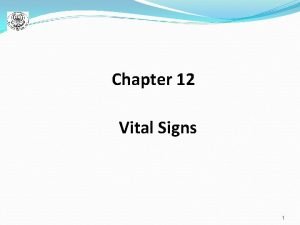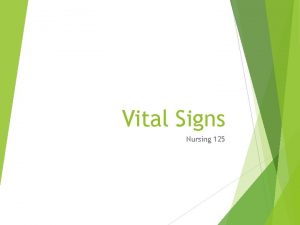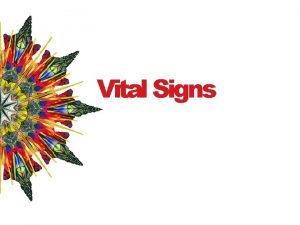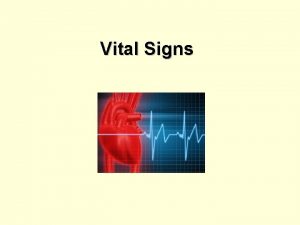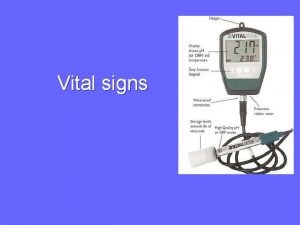Vital Signs n 1 2 3 4 Are












































- Slides: 44

Vital Signs n 1. 2. 3. 4. Are measurements of the body's most basic functions: Body temperature (Temp) Pulse/heart rate (HR) Respiration rate (RR) Blood pressure (BP) 1


Assessing Body Temperature n The normal range of the body temperature is between 35. 9 c(96. 6 f)-37. 4 c(99. 3). 3

ﺗﻐییﺮﺍﺕ ﻣﺮﺑﻮﻁ ﺑﻪ ﺳﻦ ﺩﺭ ﻋﻼیﻢ ﺣیﺎﺗی Age Temp. Pulse rate Resp. rate Blood pressure New born 36. 8 C ° Axillary 80 -180 30 -80 73/55 1 -3 years 37. 7 C° rectal 80 -140 20 -40 90/55 6 -8 years 37 C ° oral 75 -120 15 -25 95/75 10 years 37 C ° oral 75 -110 15 -20 102/80 Teens 37 C ° oral 60 -100 15 -20 102/80 Adults 37 C ° oral 60 -100 15 -20 120/80 70 years 36 C ° oral 60 -100 15 -20 120/80 normally Be up to 160/95 4









Hypothermia n HYPOTHERMIA : it is a body temperature below the normal limit – 34 c°. 13

Sites for Assessing Temperature 1. 2. 3. 4. Orally (common way). (3 – 5 min) Axillary (safe way). (10 min) Rectal (accurate reading). (2 – 3 min) Tympanic membrane. 14

Average Normal Temperature for Healthy Adults C°/ F° Oral Rectal Axillary Centigrade 37. 0 C° 37. 5 C° 36. 5 C° Fahrenheit 98. 6 F° 99. 5 F° 96. 6 F° 15

When we cannot use oral thermometer? 1. 2. 3. 4. 5. 6. The child under 6 years. Unconscious patients. Psychiatric patients. Patient who cannot breath from his nose Mouth surgery or infection. Patient on oxygen mask. 16

When we cannot use rectal thermometer? 1. 2. 3. 4. With patients who have rectal surgery. With patients who have any rectal disorders. With patient who have cardiac disorders. Decrease in platelets. 17

Thermometers n n Electronic thermometer. Glass thermometer. Paper thermometer. Tympanic membrane thermometer. 18


Pulse Rate n n n The normal heart rate in adult is ( 60 – 100 beat/min. ) TACHYCARDIA : is a rapid pulse rate , greater than 100 beat /min. BRADYCARDIA : is a pulse rate below 60 beats / min. in adults. 20

Factors Contribute to Increase Pulse Rate n n n n Pain. Fever. Stress. Exercise. Bleeding. Decrease in blood pressure. Some medications as (adrenalin, aminophylline) 21

Factors May Slow The Pulse § § § Rest. Increasing age. People with thin body size. Medication as ( digitalis ). Thyroid gland disturbances. 22

PULSE SITES TEMPORAL PULSE § CAROTID PULSE § BRACHIAL PULSE § RADIAL PULSE § FEMORAL PULSE § POPLITEAL PULSE § POSTERIOR TIBIAL PULSE § DORSALIS PULSE Auscultation APICAL PULSE with stethoscope § § 23

PULSE SITES 24

Vital Signs: n n n Pulse (cont. ) Locate pulse by pressing lightly with index and middle finger pads at the pulse site Count the number of beats felt in 1 minute If regular – may count beats for 30 seconds and multiply by 2

Vital signs: Regular Pulse Rhythm Ø Count for 30 seconds, then multiply by 2 (a rate of 35 beats in 30 seconds equals a pulse rate of 70 beats/minute) Click for Sound Pulse (cont. ) Irregular Pulse Rhythm Ø Count for one full minute Ø May use stethoscope to listen for apical pulse and count for a full minute Click for Sound

NORMAL PULSE PER MINUTE AT VARIOUS AGE Age Range Average Newborn– 1 month 120 – 160 140 1 month - 12 months 80 – 140 12 months – 2 years 80 – 130 110 2 year - 6 year 75 – 120 100 6 year - 12 year 75 – 110 95 Adolescence to adult 60 - 100 80 27



Respiration n n Respiratory rate – indication of how well the body provides oxygen to the tissues Check by watching, listening, or feeling movement

Factors Affecting Respiration n n n n Pain. Anxiety. Exercise. Medications. Trauma. Infection. Respiratory and cardiovascular disease. Alteration in fluids, electrolytes, acid- base balances. 31

Assessing Respirations n n Inspection. Listening with stethoscope. Monitoring arterial blood gas results. Using a pulse oximeter. 32

Respiration n Irregularities – indication of possible disease n Hyperventilation – excessive rate and depth n Dyspnea – difficult or painful breathing n Tachypnea – rapid breathing n Hyperpnea – abnormally rapid or deep breathing

Vital Signs: n Respiration (cont. ) Other irregularities n Rales (noisy) n n n Cheyne-Stokes respirations n n n Constriction or blockage of bronchial passages Pneumonia, bronchitis, asthma, or other pulmonary disease Periods of increasing and decreasing depth of respiration between periods of apnea Strokes, head injuries, brain tumors, congestive heart failure Apnea – absence of breathing

Vital Signs: Respiration (cont. ) Normal Respiratory Rates (26 -40) (20 -30) (18 -24) (16 -24) NOTE: Ranges reflect breaths per minute (12 -24) (12 -20)

Patterns of Respiration Desperation Normal 12 – 20 breath / minute Tachypnea 24 b / min ﺳﻄﺤی Bradypnea 10 b / min ﻣﻨﻈﻢ Hyperventilation Increased rate and depth Hypoventilation Decreased rate and depth Irregular 36

Blood Pressure n n Blood pressure: is the force required by the heart to pump blood from the ventricles of the heart into the arteries. It is measured in systolic and diastolic pressure. 37

Vital Signs: Blood Pressure (cont. ) 120/80 Systolic Pressure Diastolic Pressure Ø Contraction of left ventricle Ø Top or first number Ø Heart at rest Ø Bottom or second number

Vital Signs: Blood Pressure (cont. ) Hypertension High blood pressure readings n Major contributor to heart attacks and strokes n n n Normal for some people Severely low blood pressure readings occur with: n n Shock Heart failure Severe burns Excessive bleeding Hypotension

Blood Pressure (Cont’d) n n Systolic : is known as the force to pump blood out of the heart. Diastolic: it is known as relaxation period of the heart pump (ventricles ) Blood pressure = systolic pressure / diastolic pressure. The normal BP is 120/ 80 mm. Hg. 40

Blood Pressure (Cont’d) n n Hypertension: it means high blood pressure. Factors increasing blood pressure : n Increasing age. n Obese person. n Emotions as anger, fear. n Tension. n Exercise. n Food intake. n Illness. n Medications. 41

Blood Pressure (Cont’d) n n Hypotension: it means low blood pressure Factors that reduce blood pressure : n severe blood loss ( bleeding ) n burns. n vomiting. n Diarrhea. n medications 42

Equipment for Assessing Blood Pressure n n n Stethoscope and sphygmomanometer. Doppler ultrasound. Electronic or digital devices. 43

The End 44
 Insidan region jh
Insidan region jh Sign shapes meaning
Sign shapes meaning Volúmenes pulmonares
Volúmenes pulmonares Respiratory rate of newborn
Respiratory rate of newborn Vitals by age
Vitals by age Pediatric vital signs
Pediatric vital signs Vital signs conclusion
Vital signs conclusion Chapter 15:1 measuring and recording vital signs
Chapter 15:1 measuring and recording vital signs Baseline vital signs
Baseline vital signs Seizure precautions nursing
Seizure precautions nursing Chapter 29 measuring vital signs
Chapter 29 measuring vital signs Normal vital signs for all age groups
Normal vital signs for all age groups Positive orthostatic blood pressure
Positive orthostatic blood pressure Vital signs definition
Vital signs definition Apical radial pulse
Apical radial pulse Unit 14.1 measuring and recording vital signs
Unit 14.1 measuring and recording vital signs Chapter 26 measuring vital signs
Chapter 26 measuring vital signs Fundamentals of nursing chapter 17 vital signs
Fundamentals of nursing chapter 17 vital signs Vital signs and anthropometric measurements:
Vital signs and anthropometric measurements: Hypertension vs hypotension
Hypertension vs hypotension 16.4 measuring and recording respirations
16.4 measuring and recording respirations Pews score
Pews score Vital signs according to age
Vital signs according to age Vital sign form
Vital sign form What are normal vital signs
What are normal vital signs Purpose of vital signs
Purpose of vital signs Chapter 11 vital signs
Chapter 11 vital signs Mesure de la pression sanguine
Mesure de la pression sanguine Vitals include
Vitals include Elsevier
Elsevier Neuro vital signs meaning
Neuro vital signs meaning Vital signs normal rate
Vital signs normal rate Example of adpie
Example of adpie Normal adult vital signs
Normal adult vital signs Respiratory rate for newborn
Respiratory rate for newborn Esi classification
Esi classification Chapter 27 vital signs
Chapter 27 vital signs Chapter 14 basic nursing skills
Chapter 14 basic nursing skills Temperature
Temperature Anthropometric measurement includes vital signs
Anthropometric measurement includes vital signs Normal vital signs for all age groups
Normal vital signs for all age groups Measuring and recording vital signs
Measuring and recording vital signs Normal ranges of vital signs
Normal ranges of vital signs Respiration rate chart
Respiration rate chart Danger zone vital signs
Danger zone vital signs


